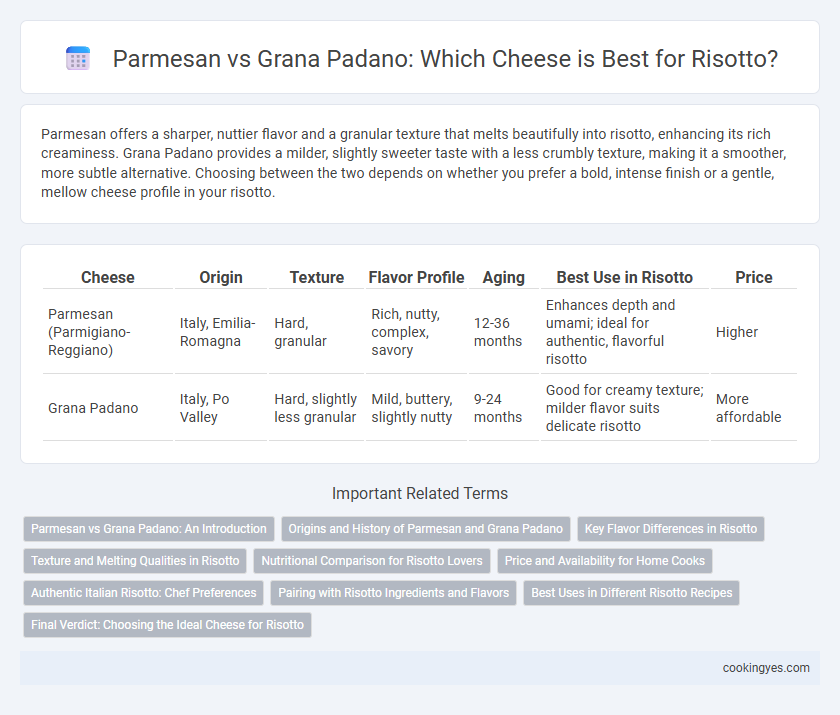Parmesan offers a sharper, nuttier flavor and a granular texture that melts beautifully into risotto, enhancing its rich creaminess. Grana Padano provides a milder, slightly sweeter taste with a less crumbly texture, making it a smoother, more subtle alternative. Choosing between the two depends on whether you prefer a bold, intense finish or a gentle, mellow cheese profile in your risotto.
Table of Comparison
| Cheese | Origin | Texture | Flavor Profile | Aging | Best Use in Risotto | Price |
|---|---|---|---|---|---|---|
| Parmesan (Parmigiano-Reggiano) | Italy, Emilia-Romagna | Hard, granular | Rich, nutty, complex, savory | 12-36 months | Enhances depth and umami; ideal for authentic, flavorful risotto | Higher |
| Grana Padano | Italy, Po Valley | Hard, slightly less granular | Mild, buttery, slightly nutty | 9-24 months | Good for creamy texture; milder flavor suits delicate risotto | More affordable |
Parmesan vs Grana Padano: An Introduction
Parmesan (Parmigiano-Reggiano) and Grana Padano are both hard Italian cheeses commonly used in risotto for their rich umami flavors and creamy texture. Parmesan boasts a more complex, nutty, and slightly granular profile due to its longer aging process, typically 12 to 36 months, whereas Grana Padano is aged between 9 to 24 months, offering a milder, sweeter, and less crumbly consistency. Choosing between Parmesan and Grana Padano for risotto depends on the desired intensity of flavor and texture, with Parmesan providing a bolder taste and Grana Padano delivering a subtler, smoother finish.
Origins and History of Parmesan and Grana Padano
Parmesan, or Parmigiano-Reggiano, originated in the Parma region of Italy during the Middle Ages, renowned for its strict production regulations and long aging process that enhances its rich, nutty flavor. Grana Padano, produced in the Po River Valley since the 12th century, offers a milder taste with a slightly creamier texture due to its broader geographic production and less stringent aging requirements. Both cheeses provide unique regional heritage that influences their distinct taste profiles, making them traditional staples in authentic Italian risotto recipes.
Key Flavor Differences in Risotto
Parmesan cheese delivers a sharper, nuttier flavor with a granular texture that melts smoothly into risotto, enhancing its creamy richness. Grana Padano offers a milder, slightly sweeter taste with a delicate, less salty profile, making it ideal for those seeking a subtler cheese presence. Both cheeses provide essential umami depth, but Parmesan intensifies the savory punch, while Grana Padano contributes a gentle sweetness that balances the dish.
Texture and Melting Qualities in Risotto
Parmesan cheese offers a granular texture and melts smoothly, creating a creamy consistency essential for classic risotto. Grana Padano has a slightly softer texture and a milder melt, producing a less intense but still rich creaminess. Both cheeses enhance risotto's mouthfeel, though Parmesan's firmer melt provides a more pronounced silkiness.
Nutritional Comparison for Risotto Lovers
Parmesan and Grana Padano both add rich, savory flavors to risotto, but Parmesan typically contains higher protein and calcium levels, enhancing its nutritional value. Grana Padano offers a slightly lower fat content and calories, making it a lighter choice without sacrificing taste. For risotto lovers, selecting Parmesan provides a nutrient-dense option with greater amino acids, while Grana Padano supports a balanced diet with fewer fats.
Price and Availability for Home Cooks
Parmesan, or Parmigiano-Reggiano, typically comes at a higher price point compared to Grana Padano, making Grana Padano a more budget-friendly choice for home cooks preparing risotto. Both cheeses offer a similar nutty and savory flavor profile, but Grana Padano is often easier to find in supermarkets due to its broader production and lower price. Home cooks seeking a cost-effective yet authentic cheese option for risotto frequently prefer Grana Padano without sacrificing taste quality.
Authentic Italian Risotto: Chef Preferences
Authentic Italian risotto often sees chefs favoring Parmesan (Parmigiano-Reggiano) for its complex, nutty flavor and granular texture that melts smoothly into the dish, enhancing depth and umami. Grana Padano offers a milder, less aged profile with a creamier consistency, making it an accessible alternative but slightly less intense in flavor. Professional chefs prioritize Parmesan for traditional risotto recipes emphasizing bold, rich taste characteristic of Northern Italian cuisine.
Pairing with Risotto Ingredients and Flavors
Parmesan offers a nutty, sharp flavor that enhances risotto with mushrooms, truffles, or saffron, adding depth and complexity to earthy or pungent ingredients. Grana Padano, milder and creamier, pairs well with vegetables like asparagus or peas, imparting a subtle, buttery richness without overpowering delicate produce. Both cheeses melt smoothly, but Parmesan's robust taste complements bold flavors while Grana Padano balances light, fresh risotto varieties.
Best Uses in Different Risotto Recipes
Parmesan cheese, known for its sharp, nutty flavor, is ideal for creamy risottos like mushroom or truffle risotto where its distinctive taste enhances depth. Grana Padano, with a milder, slightly sweet profile, suits lighter risottos such as vegetable or seafood varieties, adding subtle richness without overpowering delicate ingredients. Using Parmesan or Grana Padano depends on the risotto's main components and desired flavor intensity, tailoring the cheese choice to complement every recipe perfectly.
Final Verdict: Choosing the Ideal Cheese for Risotto
Parmesan, known for its sharp, complex flavor and granular texture, enhances risotto with a rich, nutty depth, while Grana Padano offers a milder, creamier taste that blends seamlessly into the dish. The final verdict depends on desired flavor intensity: Parmesan is ideal for a bold, traditional profile, whereas Grana Padano suits those seeking a subtler, smoother finish. Both cheeses provide authentic Italian excellence, but Parmesan remains the preferred choice for elevating risotto to a robust, savory masterpiece.
Parmesan vs Grana Padano for risotto cheese Infographic

 cookingyes.com
cookingyes.com